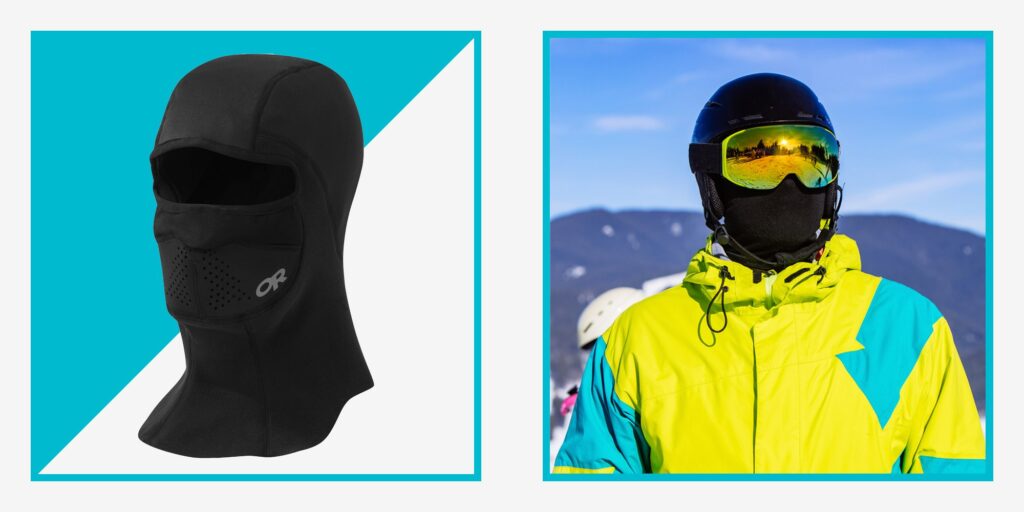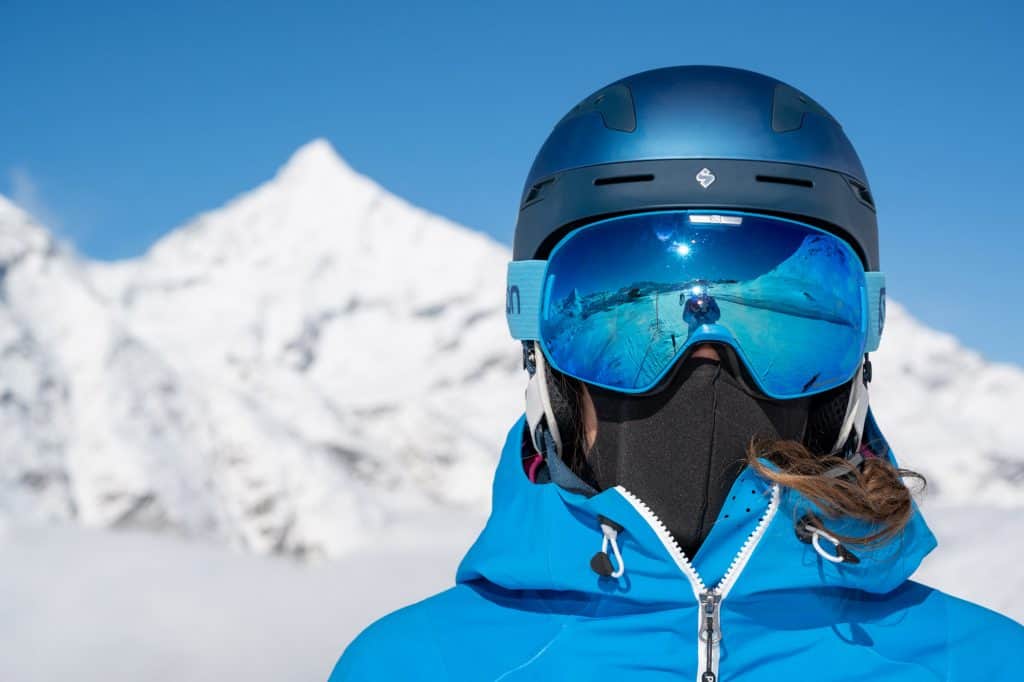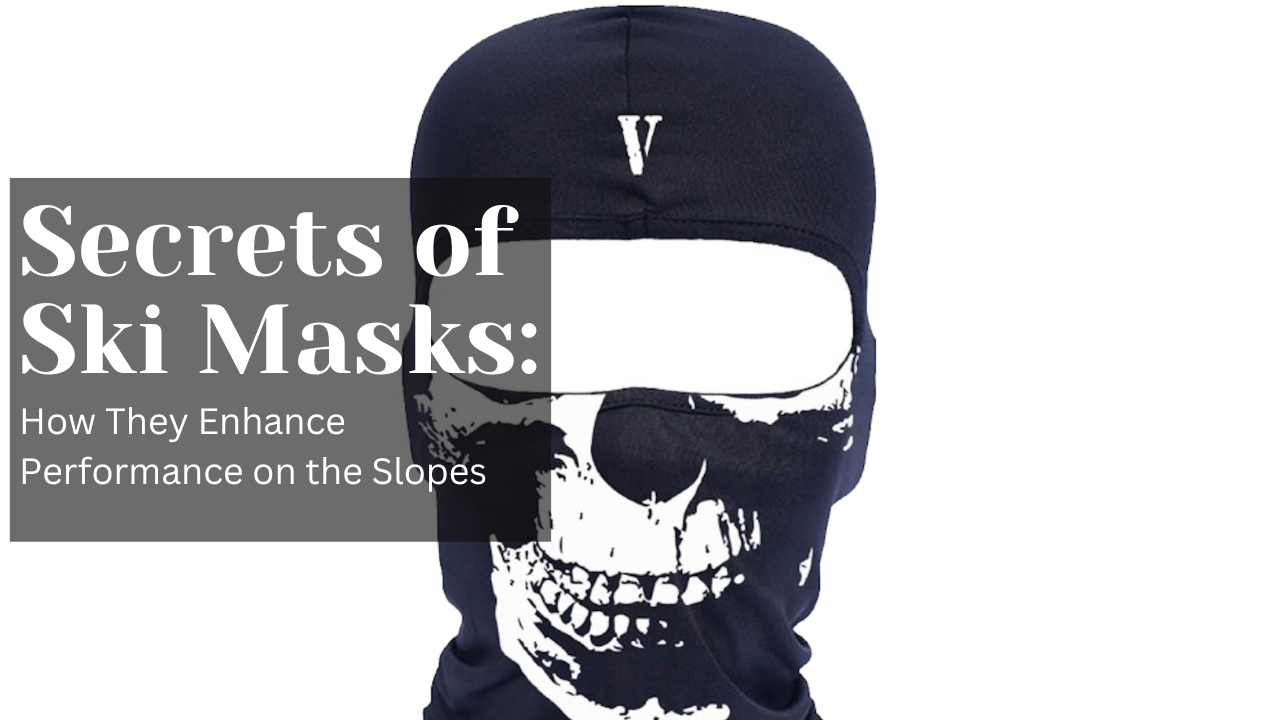Ski masks, also known as balaclavas or ski face masks, are commonly worn by skiers and snowboarders for a variety of reasons. While they primarily serve as a protective layer against cold weather, ski masks can also enhance performance on the slopes in a few ways:
- Warmth and Insulation: Ski masks are designed to provide warmth and insulation to the face, neck, and head. When exposed to cold temperatures, the body naturally diverts blood flow away from the extremities to maintain core temperature. By keeping your face and head warm with a ski mask, you can help retain body heat and prevent the discomfort and disorientation caused by extreme cold. Maintaining heat is important for optimal performance on the slopes, as it allows your muscles to work efficiently and your mind to stay focused.
- Wind and snow protection: Skiing or snowboarding at high speeds exposes your face to cold air, which can cause your skin temperature to drop significantly. A ski mask acts as a wind block and protects your face from the direct impact of cold winds. It also helps prevent snow from building up on your face, which can impair vision and cause discomfort. By reducing the impact of wind and snow on your face, a ski mask allows you to maintain better visibility and concentration, which improves your overall performance.
- Moisture Management: Ski masks are usually made of moisture-wicking and breathable material. They help manage perspiration by wicking moisture away from your skin, keeping you dry and comfortable. When you’re engaged in physical activities like skiing or snowboarding, excess moisture on your face can cause discomfort, foggy glasses, and even skin irritation. By keeping your face dry and well ventilated, the ski mask allows you to focus on your performance without distractions.
- Sun protection: Ski masks often provide additional sun protection by covering a significant portion of your face. Even on cloudy days, sunlight reflects off the snow, intensifying its effect on your skin. Wearing a ski mask with built-in sun protection or using it in conjunction with sunscreen can help protect your skin from harmful UV rays. Protecting your face from sunburn not only prevents discomfort but also helps maintain overall health and performance on the slopes.
- Psychological Benefits: In addition to physical benefits, ski masks may also provide psychological benefits to some individuals. By concealing the face, a ski mask can create a sense of anonymity and promote focus on the task at hand. This can help some people feel more confident, protected and in the zone, which can increase their performance on the slopes.
It is worth noting that personal preferences can vary, and some skiers or snowboarders may choose not to wear a ski mask due to personal comfort or style preferences. However, for many people, ski masks provide practical benefits that contribute to improved performance and enjoyment of cold weather activities.
Understanding the Purpose of Ski Masks

The main purpose of a ski mask is to shield the wearer from the weather conditions they may encounter while skiing or snowboarding, particularly cold weather, wind, snow, and sunlight. They are made to cover and shield the face, neck, and head, offering warmth, wind resistance, and sun protection.
- Insulation: The materials used to make ski masks often offer both warmth and insulation. By limiting excessive heat loss from the face and head, they aid in maintaining body heat. Since extended exposure to low temperatures can cause discomfort, frostbite, or hypothermia, this insulation is especially crucial in cold situations. Ski masks help maintain comfort when skiing or snowboarding by adding an additional layer of insulation to help control body temperature.
- Wind resistance: Skiing or snowboarding at high speeds exposes the face to solid winds, which can cause discomfort and potentially damage the skin. Ski masks act as a barrier against the wind, reducing its impact on the face. By blocking wind, they help prevent windburn, bursting and burning, so you can keep focused on your performance and enjoy your time on the slopes.
- Snow protection: Ski masks also provide protection against snow and its associated challenges. Snowflakes, ice cubes, or wind-blown snow can hit the face, causing discomfort, blurred vision, or even frostbite. The design of the ski mask helps protect the face from snow accumulation, keeping it dry and maintaining visibility. By preventing snow from obstructing your vision and causing distractions, ski masks improve performance and safety on the slopes.
- Sun Protection: Ski masks frequently offer built-in sun protection or the option to pair them with goggles, which shield the face from dangerous UV rays. Snow can reflect UV rays even on gloomy days, raising the danger of sunburn and skin damage. Ski masks with a face and neck cover offer an additional layer of sun protection, limiting exposure to UV rays and lowering the risk of sunburn and long-term solar damage.
All things considered, the main purpose of a ski mask is to shield the head, neck, and face from the harsh elements encountered during winter sports. Ski masks contribute to comfort, safety, and better skiing performance by offering insulation, wind resistance, snow protection, and sun protection.
Enhancing Visibility and Eye Protection

Ski masks are designed to provide both protection and visibility on the slopes. While their primary purpose is to protect the face from the elements, some design features can increase visibility, allowing skiers and snowboarders to see clearly. Here are some design features that improve visibility in ski masks:
- Contoured Design: Many ski masks are designed to closely fit the shape of the face. They often have contoured seams or panels that follow the natural contours of the face, providing a snug and comfortable fit. This design feature helps reduce excess fabric and bulk that can obstruct peripheral vision.
- Large eyes: Ski masks usually have large eye openings to ensure a wide field of view. The openings are generally designed to align with the eyes, allowing unobstructed vision in all directions. This design consideration is particularly important for safety, as skiers and snowboarders must be aware of their surroundings and potential obstacles.
- Ventilation openings: Some ski masks include strategically placed ventilation openings around the mouth, nose, or ears. These openings serve two purposes: they help prevent fogging on the glasses by promoting airflow, and they allow the wearer to breathe comfortably without obstruction. By reducing fogging and ensuring clear breathing, these ventilation features enhance overall visibility on the slopes.
- Goggle Compatibility: Ski masks are often designed to be compatible with goggles. They may have distinctive features such as an extended neck or a lower edge that integrates seamlessly with the upper edge of the glasses. This design ensures a secure and gap-free fit between the mask and goggles, preventing any interference with vision due to gaps or misalignment.
- Anti-fog coating or material: Some ski masks are made with a material or coating that has anti-fog properties. These special treatments reduce fogging on the inside of goggles or masks. By reducing fogging, these masks help maintain clear vision even during challenging weather conditions or intense physical activity.
- Reflective accents: Some ski masks have reflective accents or stripes on the outside. These reflective elements increase visibility in low light conditions, such as when skiing at dusk or at night. They improve the wearer’s visibility to others on a slope, thereby increasing safety.
It is important to note that while ski masks can increase visibility, it is essential to choose goggles that fit properly and provide excellent optics. The combination of a well-fitting ski mask and high-quality goggles ensure optimum visibility and clarity while skiing or snowboarding.
Improving Breathing and Comfort
Ski masks can help some degree with air filtration and warming, but the degree to which they are successful will depend on the particular design and materials employed. In order to filter and reheat the air you breathe, ski masks can do the following:
- Ski masks can serve as a physical barrier to keep some airborne particles out, thereby filtering the air. They can nevertheless assist in capturing larger particles like snowflakes, dust, or debris that may be present in the air during skiing or snowboarding, albeit they might not offer the same level of filtration as specialized breathing masks. Those who have allergies or respiratory sensitivities may benefit from this especially.
- Ski masks are primarily made to insulate the face, especially the region around the mouth and nose, and warm the breathing air. Ski masks can assist warm the inhaled air before it reaches the respiratory system by obstructing these locations. While cold air may be harsh on the lungs and irritate them, this can be especially helpful when it’s freezing outside. Ski masks can improve breathing comfort and possibly lower the risk of respiratory issues brought on by breathing cold air by warming the air.
It’s vital to remember that ski masks might not be able to filter out tiny pollutants or allergies well enough on their own. Consider utilizing specialist respiratory masks with higher filtration efficiency if you have particular respiratory difficulties or are in an area with high amounts of pollution.
Also, while ski masks could inadvertently warm the air that is breathed in, they might not be as efficient as specially made respiratory equipment or face masks made for heat. People may decide to overlay a ski mask with additional face coverings in extremely cold weather or utilize customized masks with built-in heat exchange devices to provide more warming capacity.
A ski mask’s ability to filter and warm the air that is inhaled ultimately depends on how it is made, what materials are utilized, and the particular location in which it is being used. It is usually essential to pick a ski mask that fits snugly, permits easy breathing, and satisfies your unique requirements for filtration and warmth.
Optimizing Performance and Focus
Ski masks are designed to reduce distractions caused by wind and cold weather conditions, allowing skiers and snowboarders to focus on their performance. Here’s how ski masks achieve it:
- Wind resistance: Ski masks act as a barrier against the wind, reducing its direct impact on the face and reducing discomfort caused by cold air. By blocking the wind, ski masks help prevent excessive cooling of the skin and maintain a more comfortable temperature. This wind resistance helps reduce distractions and allows the skier to focus on their activities and surroundings.
- Face and neck coverage: Ski masks typically cover the entire face and often extend to the neck, providing comprehensive protection in cold weather. By shielding the face and neck from cold air, ski masks help prevent the discomfort and discomfort caused by extreme temperatures. This coverage also helps to keep the skin warm, allows muscles to function optimally and reduces the risk of frostbite or other cold-related problems.
- Moisture Management: Ski masks are usually made from moisture-wicking materials that draw sweat away from the skin. This moisture management feature helps prevent the accumulation of sweat on the face, which can lead to discomfort and distraction. By keeping the skin dry, ski masks allow skiers to maintain a more comfortable and focused position while on the slope.
- Reduced skin irritation: Cold and windy conditions can cause skin irritation, cracking, or redness. Ski masks provide a protective layer that helps reduce direct contact between the skin and these harsh elements. This prevents the discomfort, itching and distractions caused by skin irritation, helping the skier stay focused on their performance.
- Improved Comfort: By providing insulation and warmth, ski masks create a more comfortable environment for the face and head. When skiers feel more comfortable, they can concentrate better and perform at their best. Ski masks help reduce the need for frequent adjustments or readjustments due to discomfort caused by cold air or wind, allowing skiers to maintain focus without interruption.
In short, ski masks reduce distraction from wind and cold weather by increasing wind resistance, broad face and neck coverage, moisture management, reducing skin irritation, and improving overall comfort. These features contribute to a more enjoyable and distraction-free skiing or snowboarding experience, allowing athletes to focus on their performance and enjoy their time on the slopes.
Choosing the Right Ski Mask
Selecting the appropriate size and fit for a ski mask is crucial to ensure maximum comfort, effectiveness, and overall performance. Here are some guidelines to help you choose the right size and achieve a proper fit:
- Refer to Size Charts: Most ski mask manufacturers provide size charts that correlate measurements, such as head circumference or face length, to the corresponding sizes. Consult these size charts to determine which size range best fits your measurements. Keep in mind that sizes may vary between brands, so always refer to the specific brand’s size chart.
- Consider the Coverage: Ski masks should cover the entire face, including the forehead, nose, and chin, while allowing enough space for comfortable breathing. Make sure the mask you choose provides adequate coverage without feeling overly tight or restrictive.
- Test the Fit: When trying on a ski mask, ensure that it fits snugly but not too tight. It should comfortably conform to the shape of your face without causing discomfort or pressure points. Pay attention to the fit around the nose, mouth, and ears, ensuring that there are no significant gaps or areas where the mask is loose.
- Check for Proper Alignment: The eye openings should align properly with your eyes to provide an unobstructed field of view. Make sure the mask does not impede your peripheral vision or interfere with the fit of your goggles.
- Assess Breathability: The ski mask should allow for easy and unrestricted breathing. Ensure that the material is breathable and does not restrict airflow. Test the mask by breathing deeply to ensure there are no obstructions or discomfort.
- Consider Compatibility with Goggles: If you wear goggles while skiing or snowboarding, ensure that the ski mask you choose is compatible with them. It should integrate well with the top edge of your goggles to prevent any gaps that may allow cold air or snow to enter.
- Try Different Styles and Brands: Different ski mask styles and brands may have slightly different fits. If possible, try on different options to find the one that suits your face shape and personal preferences best.
Remember, a properly fitted ski mask should feel comfortable, provide adequate coverage, allow for unrestricted breathing, and integrate well with your goggles. Taking the time to find the right size and fit will contribute to a more enjoyable and distraction-free skiing or snowboarding experience.
Care and Maintenance Tips
Proper cleaning and storage of ski masks are essential to maintain their performance, durability, and hygiene. Here are some guidelines for cleaning and storing ski masks:
Cleaning:
- Read the Instructions: Before cleaning your ski mask, refer to the manufacturer’s instructions or care label. They may provide specific guidance on the recommended cleaning methods and any precautions to be taken.
- Hand Washing: Most ski masks can be hand washed with mild detergent or soap. Fill a basin or sink with lukewarm water and add a small amount of gentle detergent. Gently agitate the mask in the soapy water, paying extra attention to areas that may have accumulated dirt or sweat. Rinse thoroughly with clean water to remove any soap residue.
- Machine Washing (if applicable): Some ski masks are machine washable. If the manufacturer’s instructions permit machine washing, use a gentle cycle and mild detergent. Place the mask in a mesh laundry bag or pillowcase to protect it from tangling or damage. Avoid using fabric softeners or bleach, as they can degrade the materials or affect the mask’s performance.
- Drying: Air drying is generally the best method for drying ski masks. Lay the mask flat on a clean, dry towel or hang it in a well-ventilated area away from direct sunlight or heat sources. Avoid wringing or twisting the mask, as this can damage its shape or elasticity.
Storing:
- Clean and Dry: Ensure the ski mask is completely dry before storing it. Moisture can lead to mold, mildew, or unpleasant odors. If necessary, allow the mask to air dry for an extended period before storing.
- Folding or Rolling: Depending on the mask’s material and design, you can fold it neatly or roll it up to save space. Folding along the seams or rolling from the bottom edge can help maintain the mask’s shape.
- Avoid Compression: Store the ski mask in a way that avoids excessive compression or pressure. Avoid placing heavy objects on top of the mask, as this can distort its shape or elasticity over time.
- Clean Storage Container: If you use a storage container or bag, ensure it is clean and dry before placing the mask inside. A breathable fabric or mesh bag can help promote air circulation and prevent moisture buildup.
- Cool and Dry Location: Store the ski mask in a cool, dry location away from direct sunlight, excessive heat, or humidity. Avoid storing it in areas prone to moisture, such as basements or damp closets.
Regular cleaning and proper storage will help prolong the life of your ski mask and maintain its functionality. Always follow the manufacturer’s instructions and consider the specific materials and features of your mask for the best care practices.

